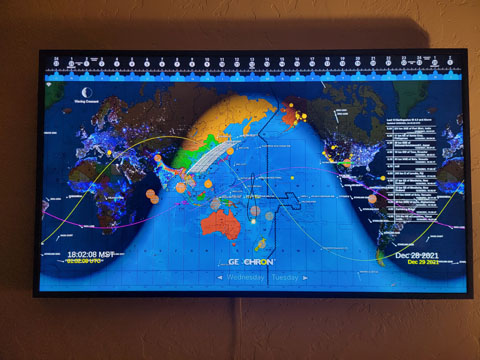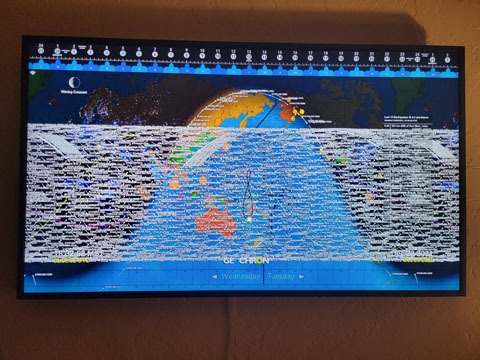|
Author
|
Topic: SpaceX Starlink satellites and orbital clutter
|
SpaceAholic
Member Posts: 5279
From: Sierra Vista, Arizona
Registered: Nov 1999
|
 posted 12-28-2021 12:40 PM
posted 12-28-2021 12:40 PM
   
China filed a complaint to the United Nations, saying Chinese astronauts aboard the country's space station had to take emergency action earlier this year to avoid colliding with Starlink satellites launched by SpaceX, reports the Wall Street Journal. The two Starlink satellites came close to the space station in July and October, Foreign Ministry spokesman Zhao Lijian said Tuesday in Beijing. At the time, Chinese astronauts were conducting missions on the station, which had to adopt emergency measures to avoid collisions, he said. |
Robert Pearlman
Editor Posts: 51189
From: Houston, TX
Registered: Nov 1999
|
 posted 12-28-2021 12:45 PM
posted 12-28-2021 12:45 PM
   
You can read the submitted complaint here. Notification by China under Article V of the Outer Space Treaty concerning preventive collision avoidance between the China Space Station (international designation 2021-035A) and United States' Starlink-1095 (international designation 2020-001BK) and Starlink-2305 (international designation 2021-024N) satellites. |
SpaceAholic
Member Posts: 5279
From: Sierra Vista, Arizona
Registered: Nov 1999
|
 posted 12-28-2021 07:18 PM
posted 12-28-2021 07:18 PM
   
The GEOCHRON absent the majority of Starlink tracks (save those launched last 30 days): With all 2000 plus (and counting):  Getting crowded and a might challenging to schedule launch windows through all that traffic! |
SpaceAholic
Member Posts: 5279
From: Sierra Vista, Arizona
Registered: Nov 1999
|
 posted 12-31-2021 06:51 PM
posted 12-31-2021 06:51 PM
   
Elon Musk says there is room for "tens of billions" of satellites, reports Business Insider. Elon Musk has pushed back on claims from the European Space Agency that SpaceX was blocking out rivals in space, saying there was room for "tens of billions" of satellites in orbit.In an interview with The Financial Times, the CEO likened the number of satellites flying in low Earth orbit (LEO) to having two billion cars and trucks on Earth. Given that orbital "shells" are bigger than the Earth's surface, "that would imply room for tens of billions of satellites," Musk told the FT. "A couple of thousand satellites is nothing. It's like, hey, here's a couple of thousand of cars on Earth — it's nothing," he added. |
Aeropix
Member Posts: 62
From: Dubai
Registered: Apr 2010
|
 posted 01-03-2022 09:57 PM
posted 01-03-2022 09:57 PM
   
Yeah, I think the Boeing 737-MAX crashes should teach us not to let the manufacturer "self-regulate". I like Elon and think he's a genius, but you still have to question how his commercial motivations may cloud his judgement over this topic. |
Robert Pearlman
Editor Posts: 51189
From: Houston, TX
Registered: Nov 1999
|
 posted 01-04-2022 05:23 PM
posted 01-04-2022 05:23 PM
   
A new, independent analysis of the Starlink constellation has found it poses no more a risk to China's space station than other items in orbit. ...the two reported Starlink conjunctions represent only a small fraction of the total expected close approaches that Tiangong would have experienced during a one-year period - just 2.4% [100 x (2 maneuvers attributed to Starlink per year) / (83.7 total avoidance maneuvers per year)]....Starlink only accounts for about 7% of all conjunctions within 5 km, and 17% of all Tiangong encounters with active spacecraft. Debris is identified as the dominant source of close approaches; debris fragments generated by China's own ASAT test in 2007 and the recent Russian ASAT test contribute to this debris risk. |
SpaceAholic
Member Posts: 5279
From: Sierra Vista, Arizona
Registered: Nov 1999
|
 posted 10-13-2023 09:44 PM
posted 10-13-2023 09:44 PM
   
From the executive summary of an updated analysis: By 2035, if the expected large constellation growth is realized and debris from Starlink satellites survive reentry, the total number of hazardous fragments surviving reentries each year is expected to reach 28,000, and the casualty expectation, the number of individuals on the ground predicted to be injured or killed by debris surviving the reentries of satellites being disposed from these constellations, would be 0.6 per year, which means that one person on the planet would be expected to be injured or killed every two years. |













